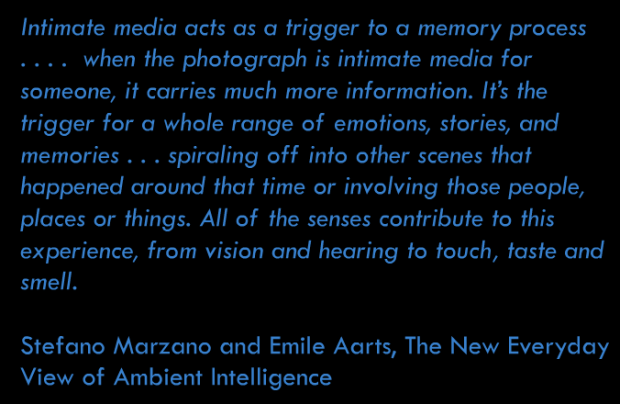Kodachrome Blue Syntax
Kodachrome Blue Syntax" is a digital composition that explores how a sense of one's past is represented and re-inflected through a montage of archival film clips and a chorus of looping, poetic voices transcoded across multiple media formats.
Artist Statement
One's memory resonates in sympathy with personal media, the diary, home movie, photograph album. This digital composition explores how a sense of one's past—perhaps the aura of childhood—is imagined and represented, and how those representations re-inflect the past. A psychologically suggestive montage of archival film clips joins a chorus of looping, poetic voices—as the material objects to which memory is anchored grow more distant, through copying and transcoding across multiple media formats. The origin of the piece is a print poem of the same title, now incorporated as an "audio track." I was interested in the peculiarity of the neologism "kodak," the fetishized color reproduction of a famous film stock "kodachrome," and used them to fashion a mantra-like rhythmic bed of sound. Poetry is sometimes associated with the immaterial, as if the poet works in a mystical space distinctive from the concerns of other artists who work physically with the materials they sculpt. I see writing as an engagement with materials (paper, page, typewriter) as much as with ideas. This became even more apparent as I worked to produce first an audio rendering, and then a multimedia instantiation of the piece. The relation of old and new media is foregounded in this piece through the framing of recognizably "vintage" footage and the dubbing in of the mechanical noise produced by an image-only film projector. This also evokes the social situation of viewing silent home movies: where viewers perform a ritual remembering of the scenes viewed and improvise an accompanying narration. In this sense, the absence of a synch-sound track invited a relationship to representation and remembering that is quite different from the viewing of contemporary digital home video.
Practioners of New Media art in the United States tend to frame the art as breaking with past forms and genres. This piece tries also to explore the continuities or recurrences in developing genres and media, past and present. In this sense, it is interested in what Jay David Bolter has called "remediation" as both new and old media are reciprocally refashioned. The voices are processed so as to invite a musical listening experience, where words begin to lose their denotative burden in the tradition of avant-garde sound poetry. The lead voice narrates a kind of commentary, knitted together of cliches and observations about a home movie. "Kodachrome Blue Syntax" (KBS) deviates from the trends in much flash-art by minimizing visual "effects" and maximizing the aural dimension. For a decade or so, Super 8mm film was the dominant middle-class, consumer medium for documenting family life in industrialized countries. Now viewed as a limiting material, with modest image resolution, short shooting time, and lack of sound—it was a powerful material nonetheless. This piece plays with the distinctive visual quality of the stock, its deep blues and graininess. In producing the quicktime loop for this piece, I also wanted to capture the suggestive effect of a childhood memory, using a sequence that depicts a father and son playing in the water at the beach. In selecting the clips and processing them, I aimed to retain the super-8 feel while also introducing a dream-like quality and marking the transcoding, from vintage film to digital format. The use of audio and video loops is designed for continuously play with the aim that they shift in relation to one another. Manovich suggests that one of the key forms of new media is the loop, which it ironically shares with the earliest motion picture technologies. But loops in KBS are not merely an evocation of past and emerging technological tropes, but are also associated with the rhythm and repetition characteristic of oral poetry. The semantic richness of poetry always demands rereading, repeated exposure. The saturation leads to an extended encounter in which an audience may move from absorption, through diminished attention, into a space where they begin to associate more freely with the piece. Perhaps they reflect upon their own childhood experiences. Ultimately the piece becomes an ambient or environmental work, as the audience performs a form of poetic remembering for themselves that parallels the ritual family activity of viewing super-8 films and providing the narration. The source text for the audio track is an original poem, recorded by the author and layered with a sampling keyboard and 8-track recorder. The source for the image loop is a reel of Super-8mm stock filmed in 1971. It has been transferred through successive media formats, including VHS, DV, Quicktime, and Flash. An amateur format, Super 8 film moves at 18 frames per second and was available in 50 foot cartridges, for a shooting capacity of 3600 frames or 3 minutes and 20 seconds. The constraints of 8mm frame rate and length have been incorporated into this flash production.
(Source: 2008 ELO Media Arts show)



